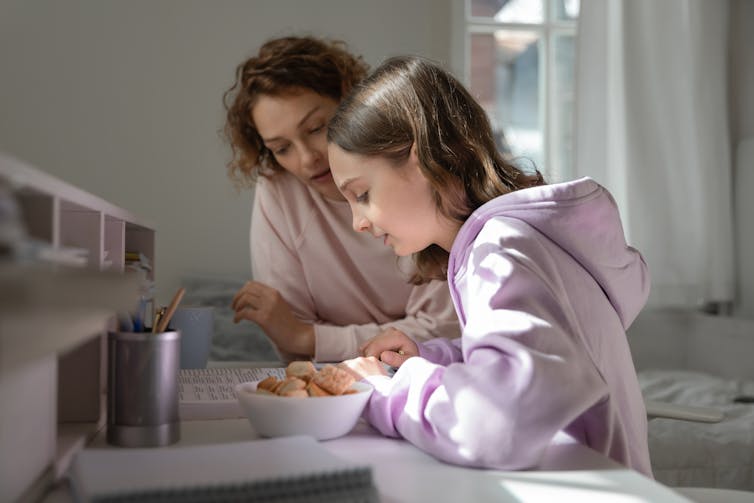Prostock-studio/Shutterstock
In many countries schools remain closed and the dinner table now serves as the school desk. This crisis has given us all new respect for the work that teachers do, but it has also given us an extraordinary moment to break the strictures of classroom learning.
While there’s been much interest in digital tools and resources to help parents support learning, we shouldn’t overlook the most flexible and practical precision tool we have at our disposal – talk.
Read more:
Explainer: what is oracy and why should every child be taught it?
In the classroom, talk is typically used by teachers to marshal a diverse group of students through a sequence of activities in an allotted time. Some students may struggle to keep up with the pace of teaching, while others may find it grindingly slow.

weedezign/Shutterstock
But now we find ourselves in a unique moment. One-to-one conversations can unfold at a pace that reflects your child’s needs and interests. This is the magic formula that private tutoring bottles and sells for a hefty price.
Talk the talk
Here are some tips on how to help your child learn through talk.
Take your time: There is now no urgency to meet an arbitrary deadline or timetable. Teachers are often having to hurry students up and shift them on to the next scheduled activity. While we adults often complain that children have limited concentration spans, in fact it’s often us who get restless and want to move on to the next thing. Let your child stay on task till they are finished.
Ask questions: Teachers often ask “pseudo” questions they already know the answer to as a way to check student understanding and attention. Once the teacher achieves the desired answer, the whole class can move on with the assumption that everyone else is on the same page. Again, teachers have had to develop this to manage the student-teacher ratio.
But at home these questions can be used to check and explore the understanding of the individual child. Even better, prompts such as “tell me about…” and “think out loud” can invite longer, more thoughtful responses.
Allow them time to think: In class, time pressures can rob students of time to think over their answers. At home, we can give thinking the time it needs. It’s very tempting as a restless adult to interrupt thinking time with new more complex versions of the same question, but try to resist this urge. If you need to ask again, don’t change the question, just repeat it – then let the thinking happen.
Discuss together: In the pressure of the classroom, students rarely ask questions about curriculum content.
You can turn this pattern on its head. If the school materials suggest a topic, then start with a shared discussion about the questions you’d both like to answer about that topic. Make a note of these questions, and then talk about how you might tackle each question.

fizkes/Shutterstock
Do some speculative thinking together – hypothesise or make some guesses together that you can later test. Stop and explore their understanding and application of ideas. Ask genuine questions that you don’t know the answer to, and share the process of wondering and enquiring. Diversions and detours are all part of the fun in exploring ideas.
Keep children involved
Read out loud: We tend to associate school reading with students reading texts out loud. Instead, use this lockdown to read out loud to your child. Take on a book that is a bit beyond their capacity, and stop after each chapter to reflect on what’s happened – and what might happen next.
Maybe alternate reading paragraphs out loud to each other, mimicking character voices for fun. Sneak in an occasional nonsensical error to check your co-reader is following closely. When big sister, brother or another carer come in, ask your co-reader to update them on the story while you get a cup of tea. You can support them with “and what about when…?”
Use your own language: Teachers tend to speak the official language of instruction, but this may be your child’s second language, or a dialect that is not used at home. Bilingualism is a valuable asset, not an impediment.
This moment is a great opportunity for you and your child to use your shared home language to explore and enrich their school learning.
Encourage children to speak up: Some of us were educated in times when children were expected to be seen and not heard. Nowadays interactive talk is understood to be an indicator of active learning and an important part of building knowledge. Talk is an extraordinary tool for making meaning and building relationships.
Enriched talk doesn’t cost anything, and you can start immediately. If schools resume under socially distanced arrangements we can expect that talk in classrooms will become more constrained. Our differently textured interactions at home can continue to provide a contrast to teachers’ talk.
![]()
Catherine Doherty receives funding from the Scottish Government's Scottish Attainment Challenge for a collaborative project on teacher education; and from the Australian Research Council for a project on private tutoring.











